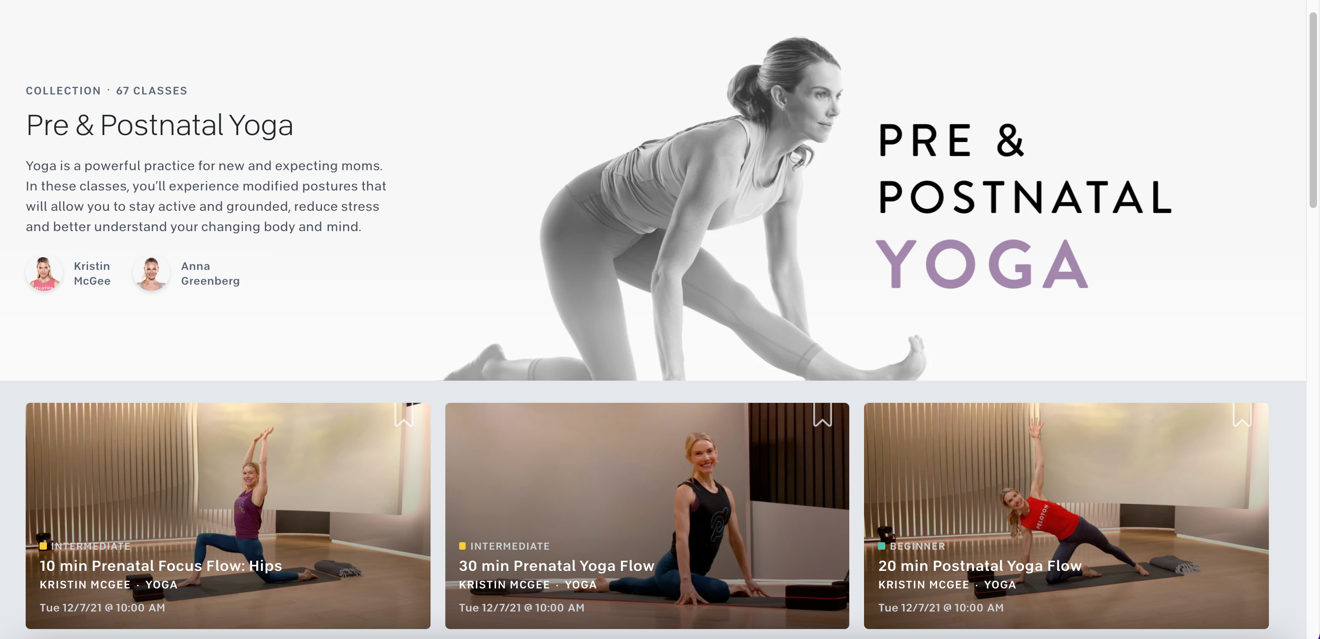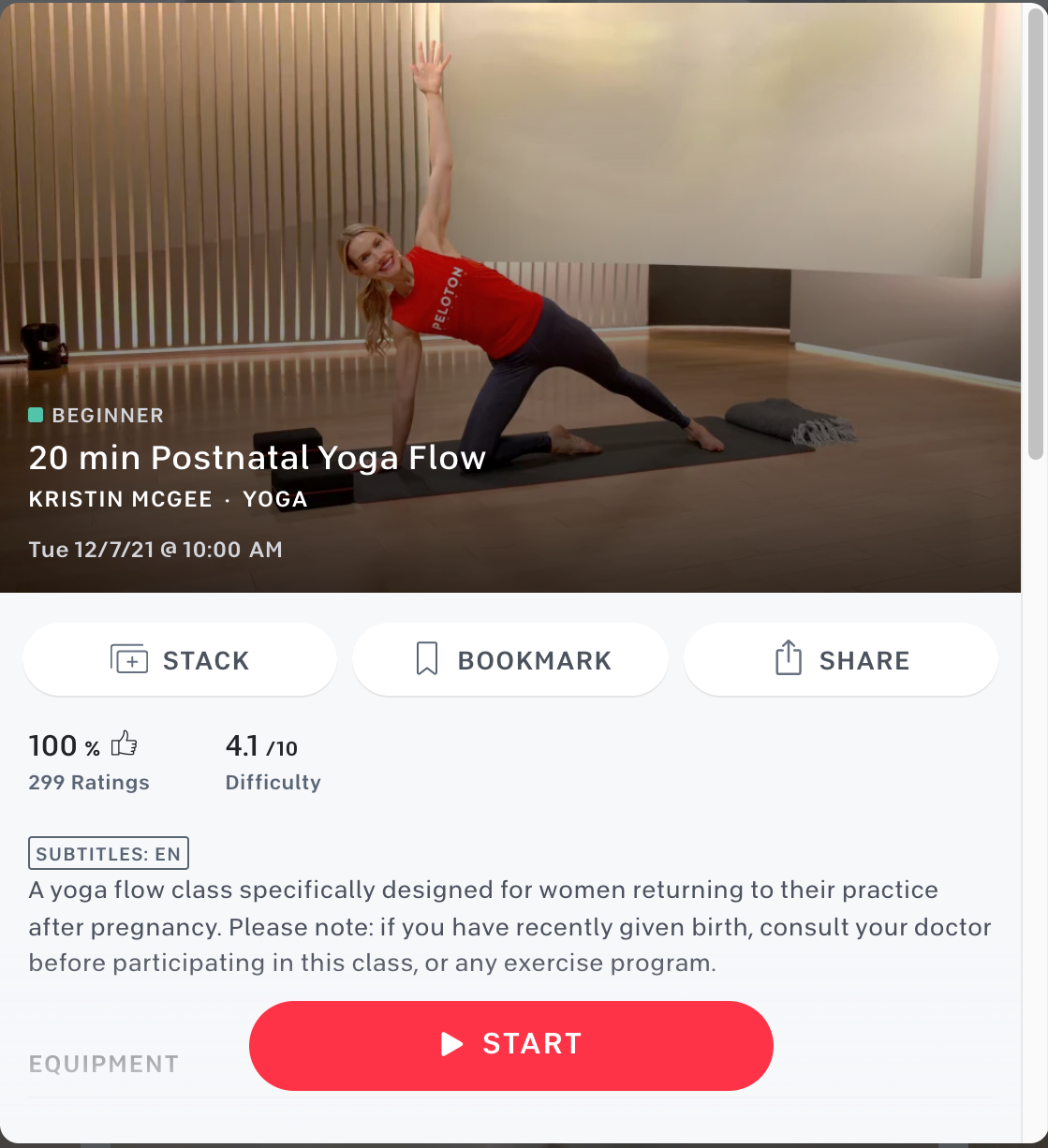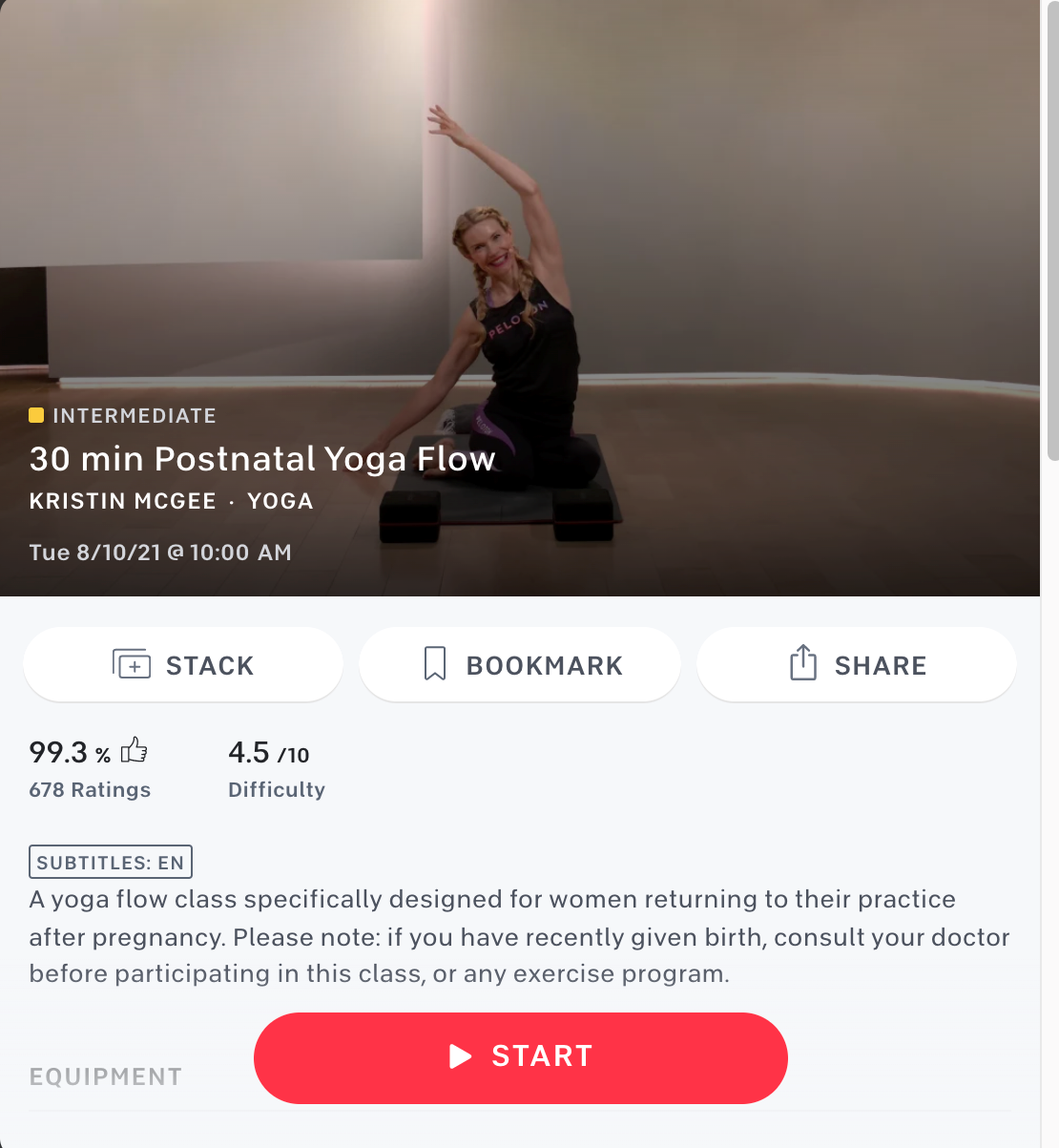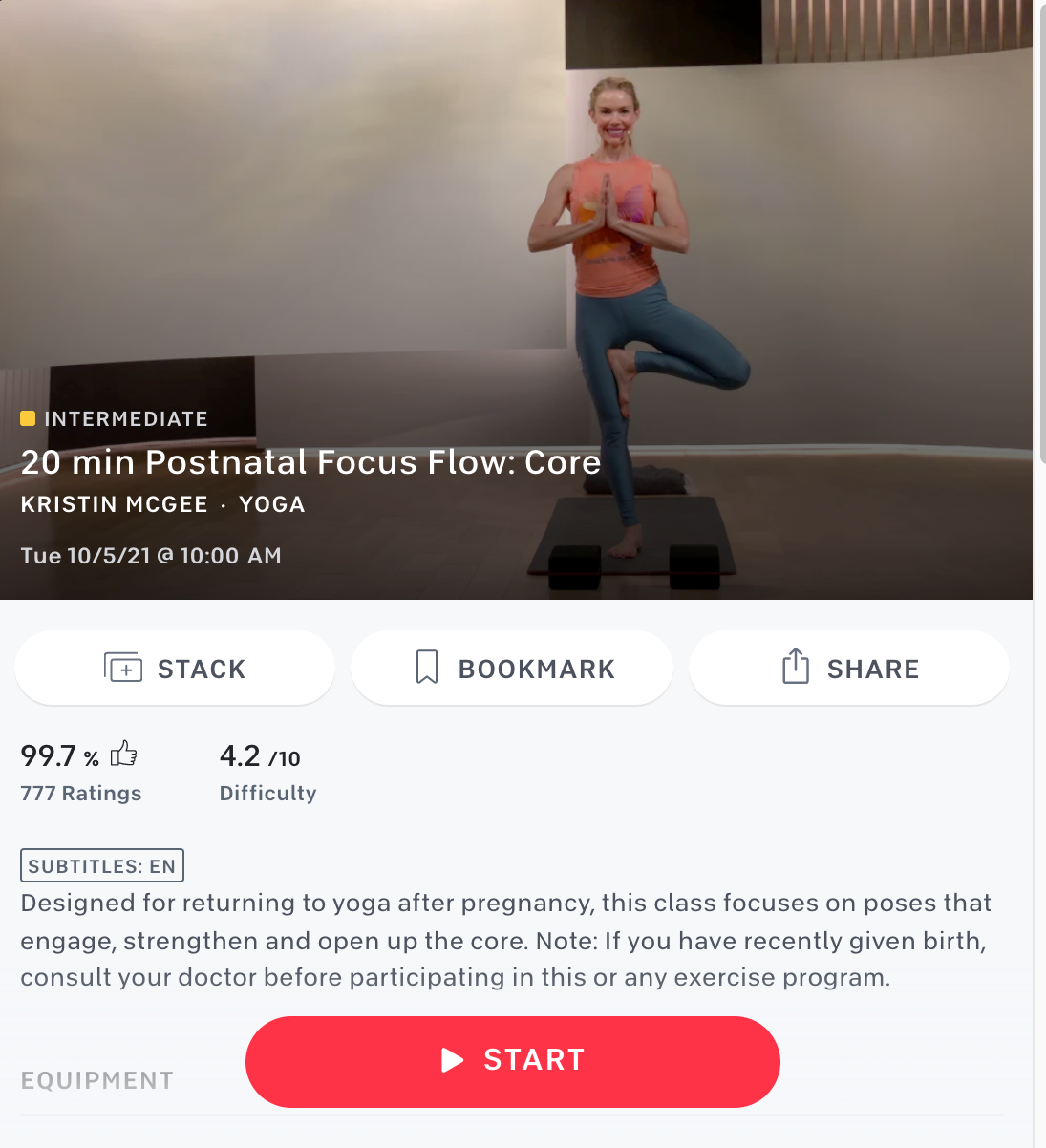Having a baby involves major changes in your life, including getting a lot less sleep and adjusting to the changes in your body. Just like with pregnancy, it takes time for your body to adjust after the baby comes. Once you are ready to get back into a normal exercise routine, Peloton has your back!
Peloton offers a variety of post-natal yoga and strength classes. The post-natal strength classes focus on core strength and are 10 minutes in length with instructor Robin Arzon. The post-natal yoga classes range from 10 to 45 minutes in length and include post-natal flow basics, yoga flow, and focus flow. These courses are taught by Anna Greenberg and Kristin McGee.
Now that we know what to look for in Peloton’s post-natal classes and some of the instructors who teach in them, let’s look at the benefits of postpartum fitness classes when you can start, and tips for success. Let’s dig in!
Contents
- Benefits of Postpartum Fitness Classes
- How Soon After Labor Can You Start Peloton Postpartum Classes?
- How Soon Can I start Spinning after Giving Birth?
- Top 10 Peloton Postpartum Classes
- 1. Post Natal Core Strength with Robin Arzon
- 2. Basics: Post Natal Yoga with Kristin McGee
- 3. Post Natal Yoga Flow with Kristin McGee
- 4. Post Natal Yoga Flow with Anna Greenberg
- 5. Post Natal Yoga Flow with Anna Greenberg
- 6. Post Natal Yoga Flow with Kristin McGee
- 7. Post Natal Yoga Flow with Kristin McGee
- 8. Post Natal Focus Flow (Core) with Kristin McGee
- 9. Post Natal Focus Flow (Hips) with Anna Greenberg
- 10. Post Natal Focus Flow (Chest Openers) with Anna Greenberg
- Postpartum Peloton and Weight Loss
- Does Peloton Have Diastasis Recti Classes?
- Tips for Successful Postpartum Workouts
Benefits of Postpartum Fitness Classes
With a newborn comes a lot of stress and anxiety, not to mention exhaustion. Many are left with additional weight gain from pregnancy, but the thought of exercising after birth when you are still trying to figure everything out can feel overwhelming.
Getting back into a regular exercise routine can help with managing that stress and losing the extra weight. According to the American College of Obstetrics and Gynecologists, exercise can also help you to better manage stress, boost energy, improve mood, and promote better sleep.
It can be tough to think about adding exercise back into your routine after having a baby. Your life and schedule have been turned upside down and it takes a while to adjust. Working on building a habit for exercise can help ease you into it.
Instead of focusing on how long your workout is, add in short bouts when you can, such as 10–20-minute sessions. Luckily, Peloton offers a variety of post-natal classes that range between 10-45 minutes in length. They allow for beginner to intermediate skill levels to help you ease back into exercise and work your way up as you are comfortable.

How Soon After Labor Can You Start Peloton Postpartum Classes?
It’s common for women to want to bounce back to their pre-pregnancy body immediately after giving birth. However, it’s important to make sure you get clearance to get back into exercise, especially if you had a C-section or other complications during delivery. In these cases, always speak to your doctor before incorporating exercise back into your routine to make sure it is safe for you to do so.
According to the American College of Obstetrics and Gynecologist, for those who had a healthy pregnancy with a vaginal birth, it is generally safe to incorporate light exercise back into your routine a few days after delivery once you feel ready.
When getting back into exercise, avoid high-intensity, rigorous, or strenuous exercise immediately after giving birth. Instead, aim for 20-30 minutes a day of simple, postpartum exercises that include strengthening major muscle groups. You can work yourself up to gradually add more moderate-intensity exercise as you see fit. If this is overwhelming in the beginning, aim to meet at least 10 minutes a day.
How Soon Can I start Spinning after Giving Birth?
Recovery time after birth varies from person to person and depends on their pregnancy and delivery. If you had a healthy pregnancy with a vaginal delivery, you could start spinning shortly after birth when you feel comfortable. If you are new to spinning, you may want to invest in a pair of padded bike shorts to make you feel more comfortable when getting used to the bike as it will often leave your seat sore.
If you have had a C-section, be sure to get clearance from your physician before starting exercise. Be mindful that leaning over during spin classes can put a strain on your C-section incision or scar which might cause discomfort or risk for re-opening the incision if it has not had enough time to properly heal.
Top 10 Peloton Postpartum Classes
Peloton offers a wide variety of classes. However, for those looking for post-natal exercise classes, your choices mainly include strength or yoga. Below are some of the top 10 Peloton post-natal classes available and how they can be beneficial during your postpartum journey.
1. Post Natal Core Strength with Robin Arzon
This 10-minute class focuses on rebuilding postnatal core strength. This class consists of a 1-minute warm-up followed by 9-minutes of core body weight or light hand weight exercises. Robin Arzon’s classes are not labeled by skill level. However, they are rated 4.6/10 for difficulty.
Instructor Robin Arzon has a collection of classes available through the Peloton app geared towards core strength for both pre-natal and post-natal in “Robin’s Prenatal and Postnatal Class Series.” Most of her classes aside from post-natal core strength are geared towards pre-natal where there are a lot more options, including full-body, lower and upper body focused classes.
Robin Arzon’s 10-minute post-natal core strength class provides simple body weight and light hand weight exercises that help to strengthen your core for post-natal recovery. Focusing on strength in this area after delivery will help to reduce back pain, get you back on track with your workouts safer, and help you keep up with your new little one.
Level: *no level*
Length: 10 minutes
Equipment: a mat and some light weights

2. Basics: Post Natal Yoga with Kristin McGee
This class is a 10-minute yoga basics tutorial on post-natal yoga. This class is not rated by skill level but is generally recognized as beginner. The focus of this class is being mindful of changes your body went through and using this class as a segue to other post-natal yoga classes.
Whether you are new to yoga, or you’ve taken some time before pregnancy, a post-natal yoga basics tutorial can help you to learn about your new body and how to move in a way that feels best for you. This class provides modifications as needed and encourages gentle movement to set the groundwork for future intermediate poses.
Level: *no level*
Length: 10 minutes
Equipment: 2 yoga blocks, a yoga blanket, and a yoga mat.

3. Post Natal Yoga Flow with Kristin McGee
This beginner 20-minute yoga class focuses on traditional yoga flow for those newer yogis. This class consists of a 7-minute warmup, 2-minute sun salutations, 7-minute flow, 3-minute final poses, and 1-minute savasana.
This class is specifically designed for women returning to their practice after pregnancy. Instructor Kristin McGee encourages you to adapt movements if anything feels difficult and offers modifications during the class for those who need them. Adding yoga to your postpartum routine can help you to increase calmness and reduce anxiety and depression symptoms.
Level: beginner
Length: 20 minutes
Equipment: yoga blanket, yoga mat, and yoga block.

4. Post Natal Yoga Flow with Anna Greenberg
This intermediate yoga class is a step up from Kristin McGee’s 20-minute beginner class. It consists of a 6-minute warm-up, 3-minute sun salutations, 5-minute flow, 6-minutes of final poses, and a 1-minute savasana. Modifications will be offered during the class for those who need them.
Getting into a regular exercise routine that includes yoga can help you to better manage your stress and increase your energy levels during a challenging time. The stretches and meditation provided in Anna Greenberg’s post-natal yoga flow and other Peloton post-natal yoga classes can help to increase blood flow and relaxation.
Because the class is shorter than many other traditional yoga classes, it is easier to fit into a busy schedule.
Level: intermediate
Length: 20 minutes
Equipment: yoga blanket, yoga mat, and a yoga block.

5. Post Natal Yoga Flow with Anna Greenberg
For those beginning yogis looking to work towards building a foundation with yoga, Anna Greenberg’s beginner post-natal yoga flow 30-minute class helps you to build up from the 10 and 20-minute yoga classes towards a more intermediate level. This course consists of a 9-minute warm-up, 4-minute sun salutation, 8-minute flow, 9-minutes of final poses, and a 1-minute savasana.
Level: beginner
Length: 30 minutes
Equipment: yoga blanket, yoga mat, and yoga block.

6. Post Natal Yoga Flow with Kristin McGee
This post-natal yoga flow class is the perfect segue from Anna Greenberg’s 30-minute beginner course. This course consists of a 7-minute warm-up, 4-minute sun salutation, 14-minute flow, 5-minutes of final poses, and a 1-minute savasana.
Level: intermediate
Length: 30 minutes
Equipment: yoga blanket, yoga mat, and yoga block.

7. Post Natal Yoga Flow with Kristin McGee
This post-natal yoga flow course is for those with a higher yoga skill level who are looking to build up their yoga workout. This course consists of an 8-minute warm-up, 2-minute sun salutation, 22-minute flow, 11-minutes of final poses, and a 1-minute savasana and is the longest post-natal yoga course offered for those looking to extend their class time.
Level: intermediate
Length: 45 minutes
Equipment: yoga blanket, yoga mat, and yoga block.

8. Post Natal Focus Flow (Core) with Kristin McGee
This class focuses on yoga for core strength. It is an intermediate class that consists of 7-minute warm-up, 2-minute sun salutations, a 7-minute flow, 3-minute final poses, and a 1-minute savasana.
Similar to post-natal core strength with Robin Arzon, this class helps to build back your core foundation to help you keep up with your growing family, avoid injury and improve back pain. When combined with a yoga flow, you also get the added benefits of meditation and breathing during poses to help encourage relaxation and clear your mind.
Level: intermediate
Length: 20 minutes
Equipment: yoga mat, yoga blanket, and yoga block.

9. Post Natal Focus Flow (Hips) with Anna Greenberg
This class focuses on poses that help to strengthen, engage, and open your hips. This can help loosen tight hips and improve range of motion and circulation in this area. This course consists of a 5-minute warm-up, 4-minute sun salutation, 8-minute flow, 2-minutes of final poses, and a 1-minute savasana.
Level: intermediate
Length: 20 minutes
Equipment: yoga blanket, yoga mat, yoga block, and a yoga strap.

10. Post Natal Focus Flow (Chest Openers) with Anna Greenberg
This class focuses on poses that help to strengthen, engage, and open your chest. A very beneficial yoga class for those who want to open the muscles in their chest and help reverse forward-leaning posture. This course consists of a 6-minute warm-up, 3-minute sun salutation, 5-minute flow, 6-minutes of final poses and a 1-minute savasana.
Level: intermediate
Length: 20 minutes
Equipment: yoga blanket, yoga mat, and yoga block.

Postpartum Peloton and Weight Loss
A common complaint by many women is wanting to bounce back to their pre-pregnancy body after giving birth. However, this takes time. With a consistent exercise routine, you will see more positive changes in your body as well as your mind. Adding in some of the postpartum Peloton classes mentioned above can help to facilitate weight loss and muscle toning after childbirth.
Can I Lose Weight with Peloton?
Peloton classes can help with weight loss by increasing the amount of energy your body is burning each day. Although exercise is an essential component in both a healthy lifestyle and for those looking to lose weight, other lifestyle factors need to be considered as well.
If not combined with changes in diet, exercise may not have as big of an impact on weight as you may have thought. This is because some may experience increased hunger with exercise, or they may end up eating extra after exercise believing they have made up for those calories. Unfortunately, we often don’t burn as many calories as we think we do during a workout and end up overestimating what we burn and underestimating what we eat.
Is It More Difficult to Lose Weight Postpartum?
Postpartum weight loss is different for every woman. We cannot stress this enough. This can also depend on how much weight you gained during your pregnancy and what your weight loss goals are. It is going to be more challenging for someone who gained 50 pounds during pregnancy to lose that weight versus someone who gained 25 pounds.
Losing weight after having a baby is not any more challenging than losing weight in general. However, when you have a newborn baby to care for, you lose sleep, and you don’t have as much free time which can make it seem more overwhelming. Be sure to be kind to yourself and know that each person has their own journey!
Does Peloton Have Diastasis Recti Classes?
Peloton does not currently have any post-natal classes with specific exercises geared towards Diastasis Recti.
Emma Lovell, Peloton’s senior instructor, has referred to requests for specific Diastasis Recti classes with two 5-minute core workouts posted on her Facebook account that are Diastasis Recti safe.
Both workouts mainly focus on the basics of deep breathing and using those breathing techniques with basic movements to help repair and rebuild your core. For those with Diastasis Recti, avoid any exercises that cause the inner part of your abdomen to bulge, including heavily lifting/straining, crunches, ab twists, or planks.
Tips for Successful Postpartum Workouts
It’s easy to get excited to get back into a workout routine, especially since it’s likely been a while since you had a proper workout. Before you jump into a new exercise routine postpartum, consider some of the tips below to make your transition easier and reduce your risk of injury.
- Ease into it: When beginning post-partem workouts, always remember to ease into exercise gently. Your body has gone through a lot and jumping into an intense exercise routine can result in injury and other frustrating setbacks. If you were not active during pregnancy, or even before, consider starting with a low impact walk and some stretching. If you are interested in Peloton’s post-natal yoga, be sure to take Kristin McGee’s 10-minute Basics Post Natal Yoga class to lay the groundwork for your exercise routine.
- Warm-Up: If you are not taking a class that includes a warm-up, be sure to add that in before you jump into your workout. This helps to increase blood flow to your muscles which can help decrease post-workout soreness and the risk of an injury.A warmup can include any form of light activity, such as a walk, a light jog, or skipping rope. Your warmup should be at least 5 minutes in length or longer if you need it.
- Stretch: As equally important as the warmup to prevent injury, you always want to make time post-workout to stretch out your muscles, even in yoga. Stretching can help to reduce the amount of lactic acid in our muscles that build up during exercise.This lactic acid is what causes our muscles to feel sore. Stretching also helps to increase flexibility and range of motion so that you are less likely to incur an injury during your next workout.
- Find a routine that works for you: When we decide we are ready to jump back into an exercise routine, sometimes we have an idea in our head of what that will look like. Whether we plan to workout 5-days a week or 3, for an hour or only 10-minutes, make sure that routine will work for you and your schedule.Having a newborn takes a lot of time, energy, and effort to care for. If you are struggling to get in a workout 5-days a week, consider when it’s best for you. Make sure you can enjoy, unwind and de-stress during your exercise and you are not trying to rush through it to get it done. You may not be able to start with 5 days of exercise a week and that’s okay. Make sure whatever routine you choose is realistic and sustainable. You can always work your way up!
- Be kind to yourself – One of the most important tips to remember when starting a postpartum workout routine is to be kind to yourself. Give yourself grace as you are juggling a lot and you just made life with your body. It’s easy to beat ourselves up for not being where we were before we gave birth or even got pregnant. Don’t let that get you down, that is normal and expected during this time, but it does not mean it will stay that way.
